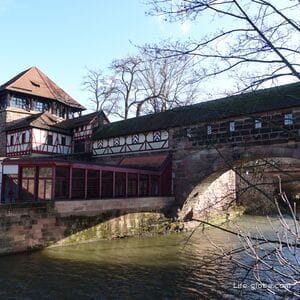Nuremberg is a beautiful Bavarian city, the core of which is the Old Town (Altstadt), which has medieval features and an abundance of attractions. Every year, on Christmas Eve, the old town hosts Christmas fairs.
Most of the old city of Nuremberg is surrounded by a City Wall (Stadtmauer Nürnberg), which has entrance gates and defensive fortifications.
The wall, like most of the city's attractions, was badly damaged during World War II. Nevertheless, the wall was restored or rebuilt in parts.
Today, the fortress wall of Nuremberg is one of the most important artistic and architectural monuments in the city.
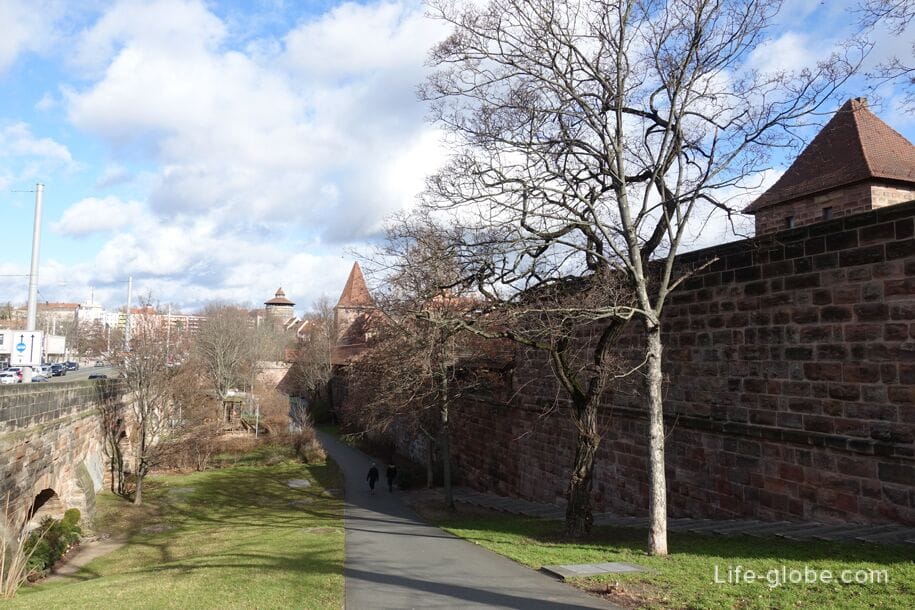
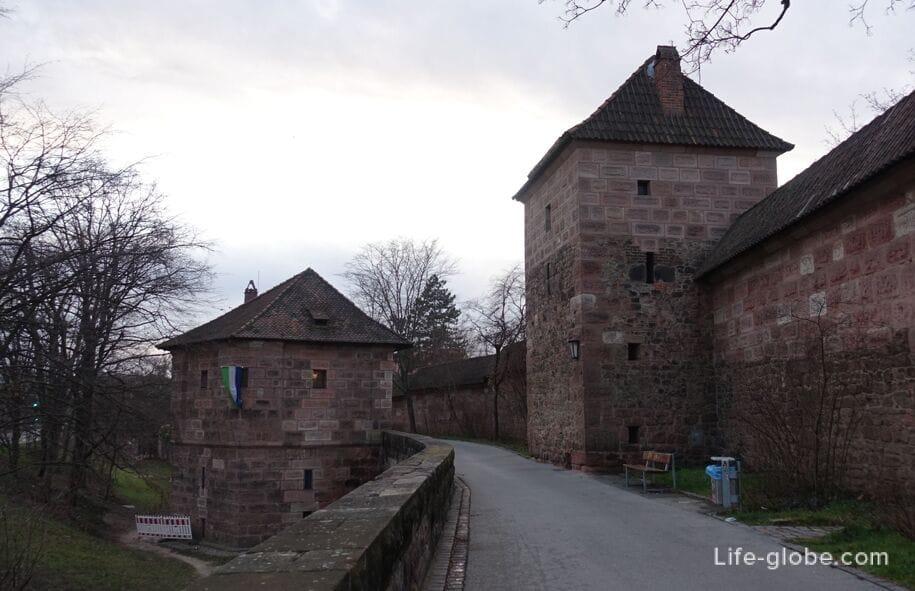
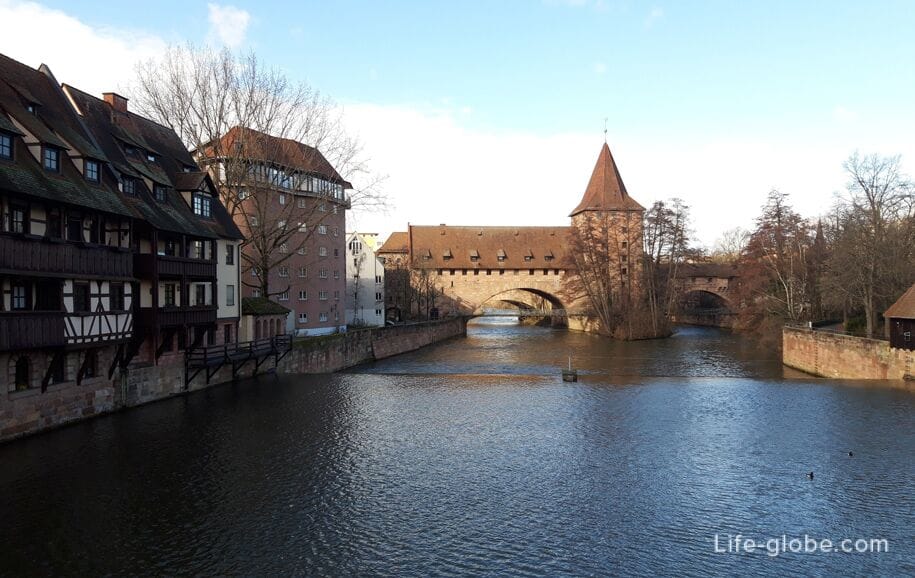
It is believed that the first fortifications of the city date back to the 11th-12th centuries, and they have not survived to this day.
In the 13th century, new (penultimate) fortress walls were erected, which were divided into northern and southern, and between them flowed Pegnitz River. The walls were separately fortified by Sebald (Sebalder) and the settlement of Lorenz (Lorenzer Siedlung).
From the fortification of the 13th century in the city preserved:
- Clock gate tower (Laufer Schlagturm) on the Sebald side;
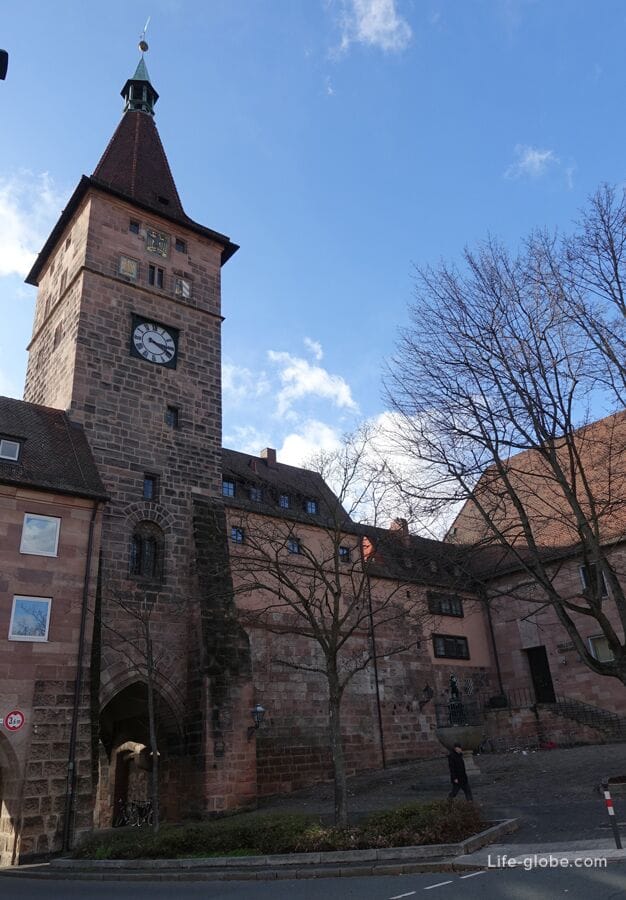
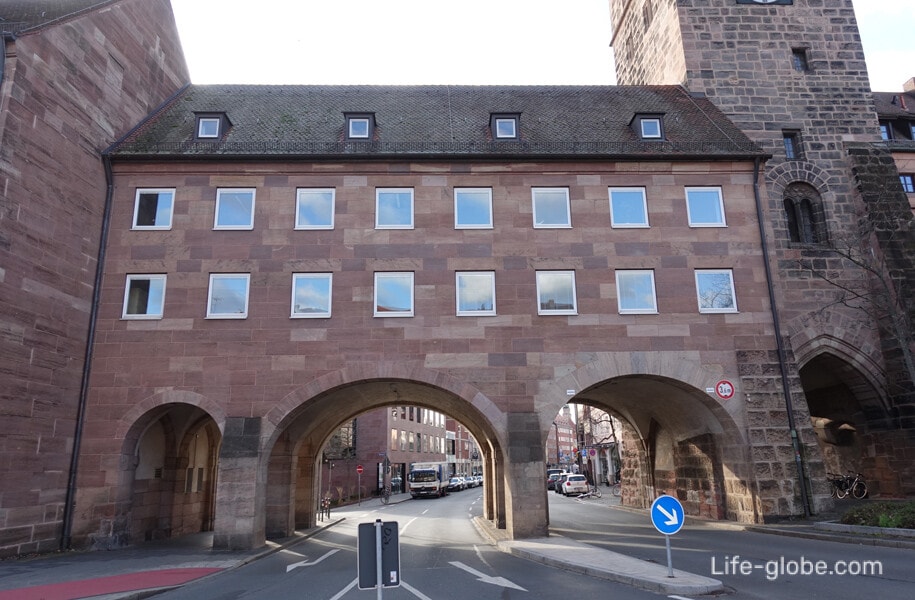
- The White Tower (Weißer Turm) on the Lorenz side;
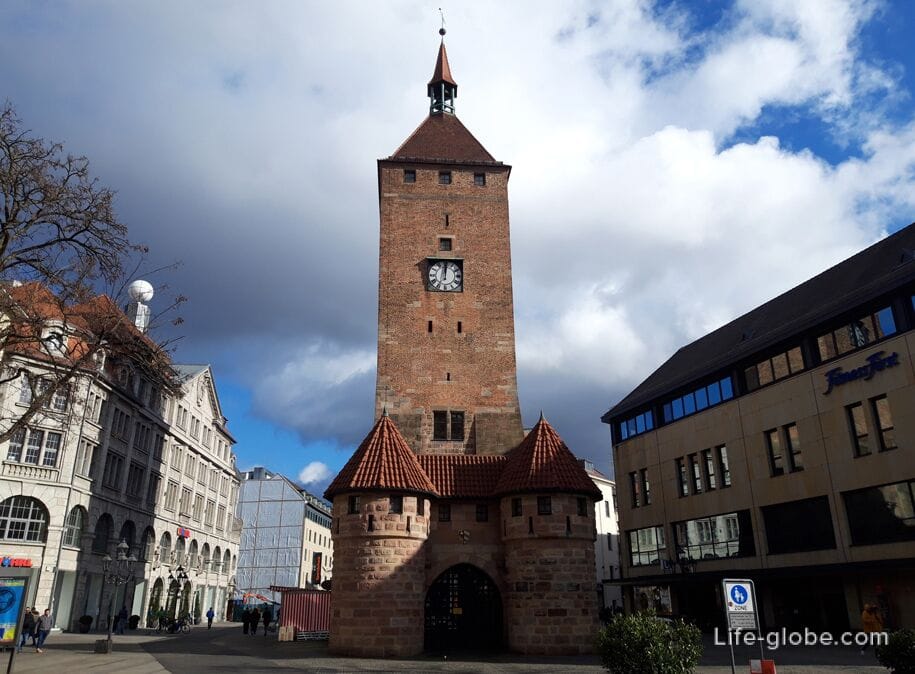
- small remains of the moat, some of which can be seen near Shooting club houses (Herrenschießhaus).
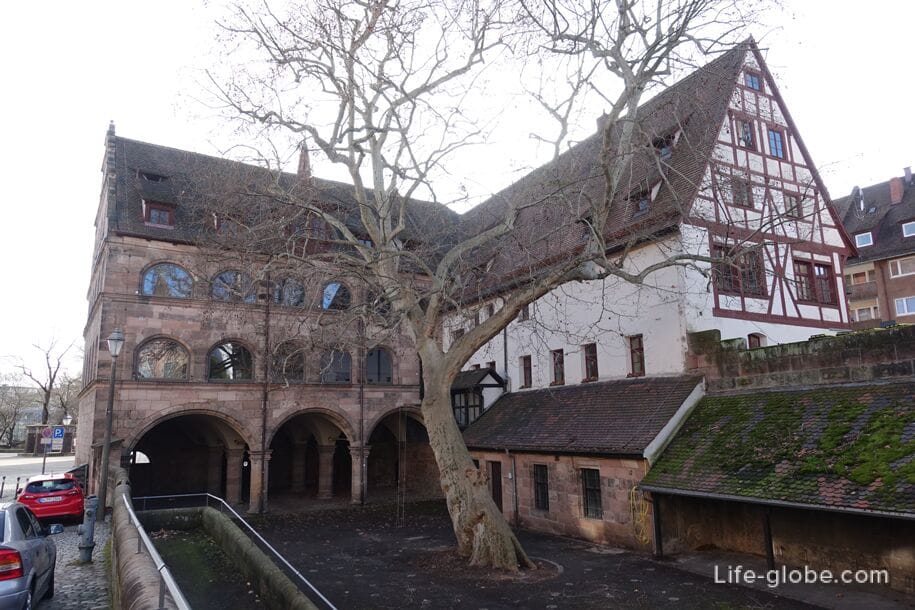
In 1320-1325, both parts of the city were connected by walls across the river. From the unification of the city walls now along the Pegnitz River have been preserved:
- Hangman's Tower (Henkerturm) and water tower (Wasserturm), built in 1320-1323 as part of the connecting bridge over the Pegnitz River;
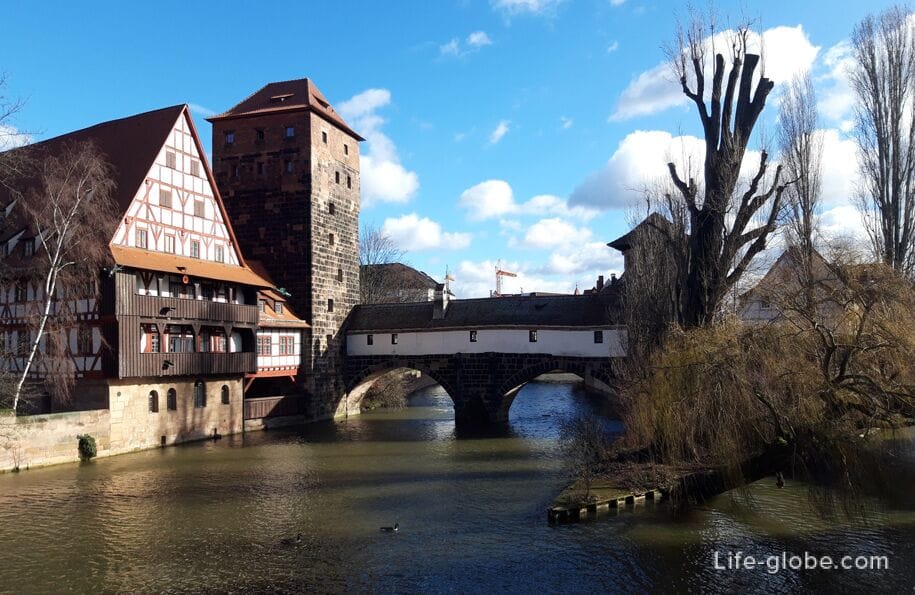
- the Debtors' Tower (Schuldturm) on the island of Schütt, built in 1323 under the supervision of the master builder Konrat Stromer. Since the tower was already located within the city after its construction, it was turned into a prison for debtors, and also used as so-called stupid houses for the mentally ill. Hence the name - "Debtors' Tower".

The last city wall, which closed around Nuremberg (now the old city of Nuremberg), was erected by 1400. The wall had a length of 5 kilometers, fortified towers, gates with gate towers and a moat.
Since 1500, the wall has been reconstructed. Then the old towers were reconstructed or demolished, as well as new towers and bastions were erected. At that time, some of the towers acquired their current appearance.
In the future, the wall lost its strategic function. During the Second World War, the city fortifications were partially severely damaged by air raids. After the war, the ruins were partially repaired. Then procedures were carried out to restore part of the wall, one of which took place in 2005.
Today, the gates and 71 towers have been preserved in the Nuremberg wall, some of which are used by organizations and individuals. Behind, on and in front of the wall, as well as in the moat that has been preserved in places, there are now mainly pedestrian paths available for public use; and the moat itself is largely designed as a park. The former mighty bastions to the west and north of Nuremberg Castle are arranged as a castle garden and are usually accessible during the warmer months.

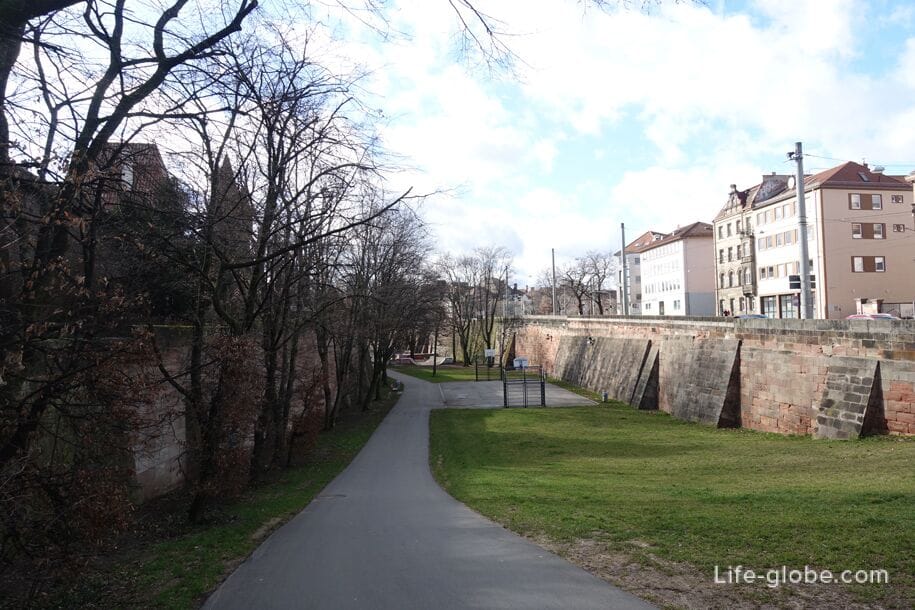

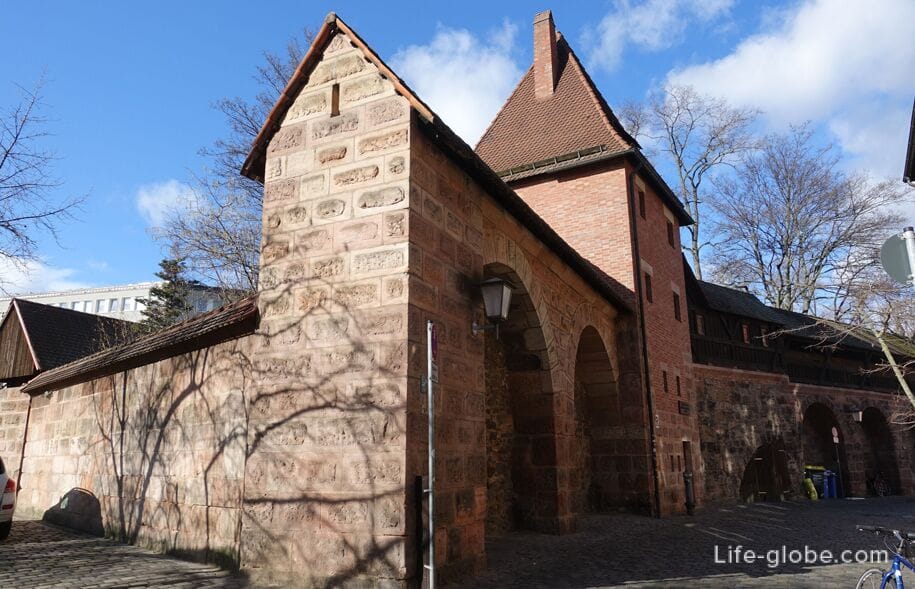


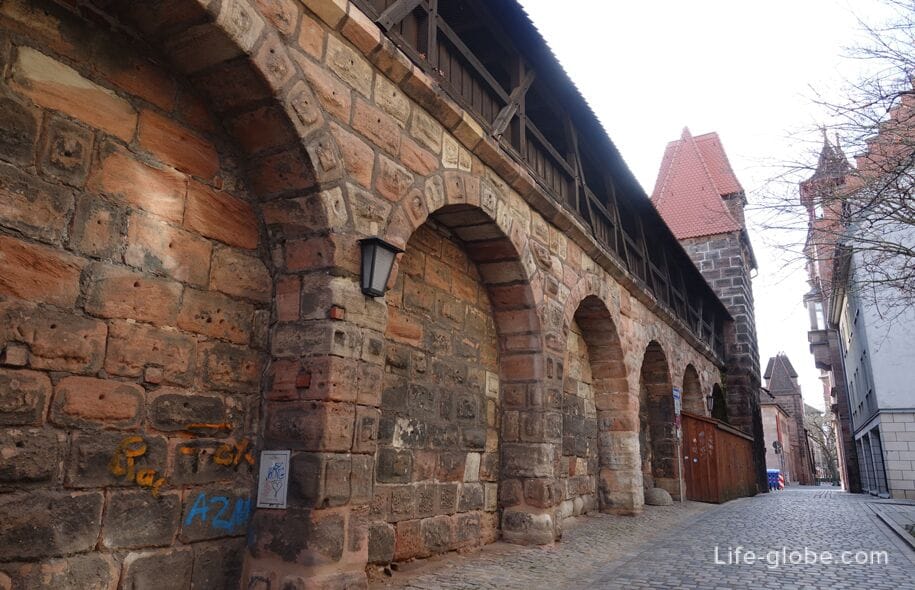
Of the most interesting parts of the fortress wall of Nuremberg , one can distinguish
The gate tower of the Women's Gate and the Women's entrance Gate (Frauentor), which were the main gate in the southeast of the city. A bridge leads to the gate, below the level of which there is a moat.
Behind the gate there is a Handicraft yard (Handwerkerhof Nürnberg), the characteristic structures of which are small buildings with imitation half-timbered facades.
Craft and souvenir shops, shops, cafes and restaurants are located in the houses, which offer such specialties as: Nuremberg sausages, Franconian beer and specialty wines, Nuremberg gingerbread, as well as wooden and tin toys, local souvenirs and other goods, including handmade. Learn more about the Craft Yard...
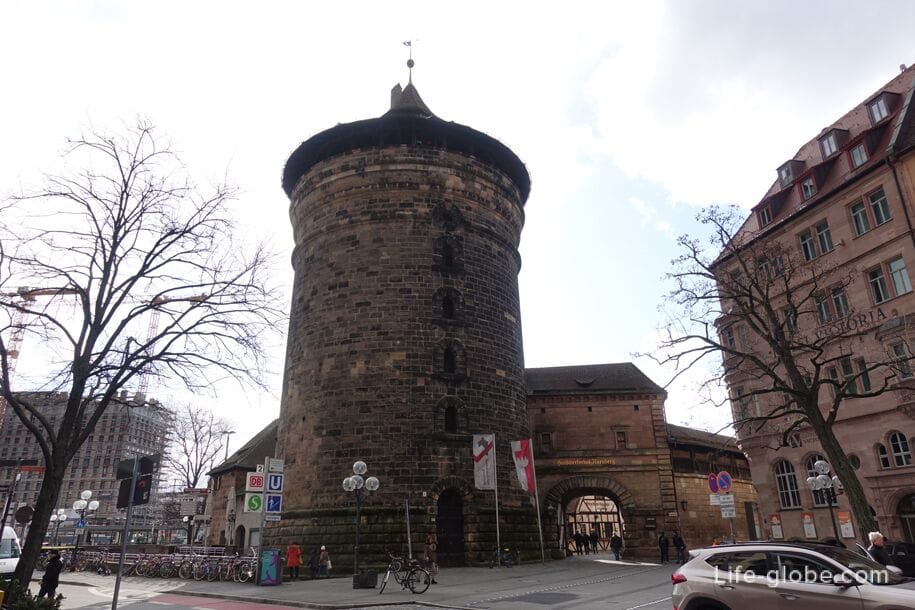
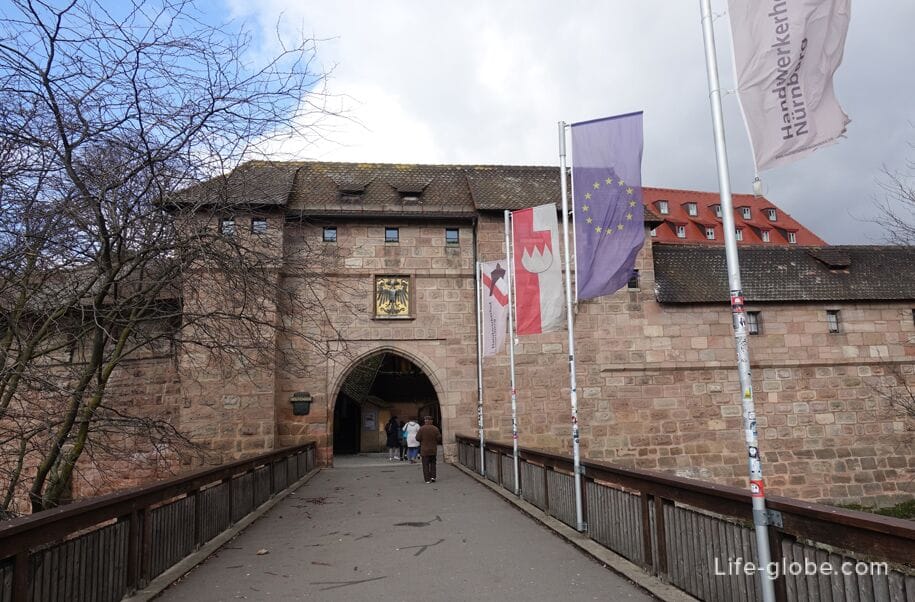
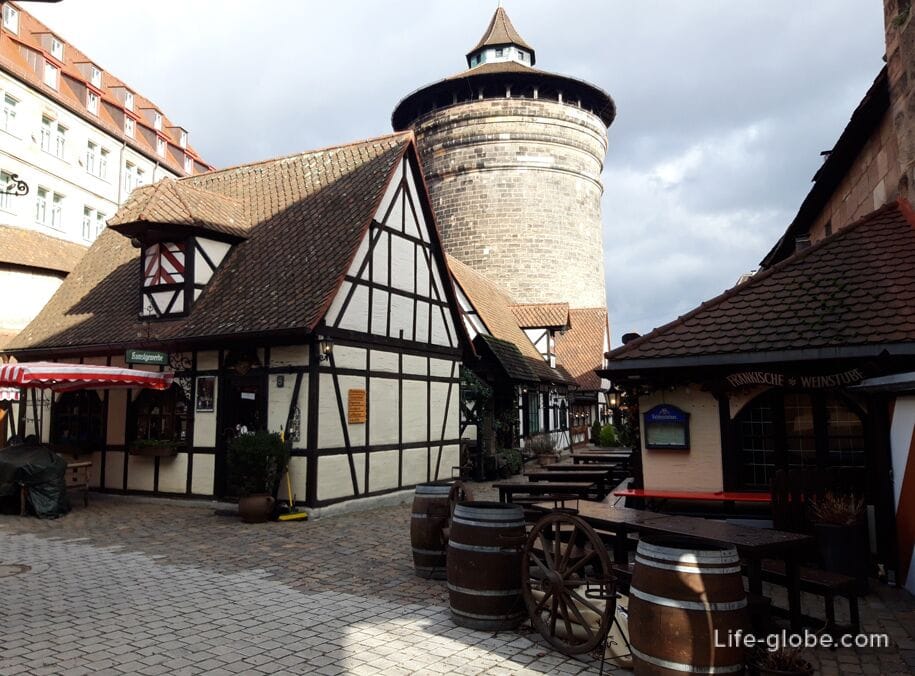
Cartesian gates (Kartäusertor) and walls.
The Cartesian gate is adjacent to the wall, has a gable roof, a large central arch - entrance / exit, flanked by another passage.
On the inside of the gate in the old town runs the Human Rights Street (Straße der Menschenrechte), and near the outer wall there is a former moat and a beautiful building stands The State Theater of Nuremberg (Staatstheater Nuremberg).
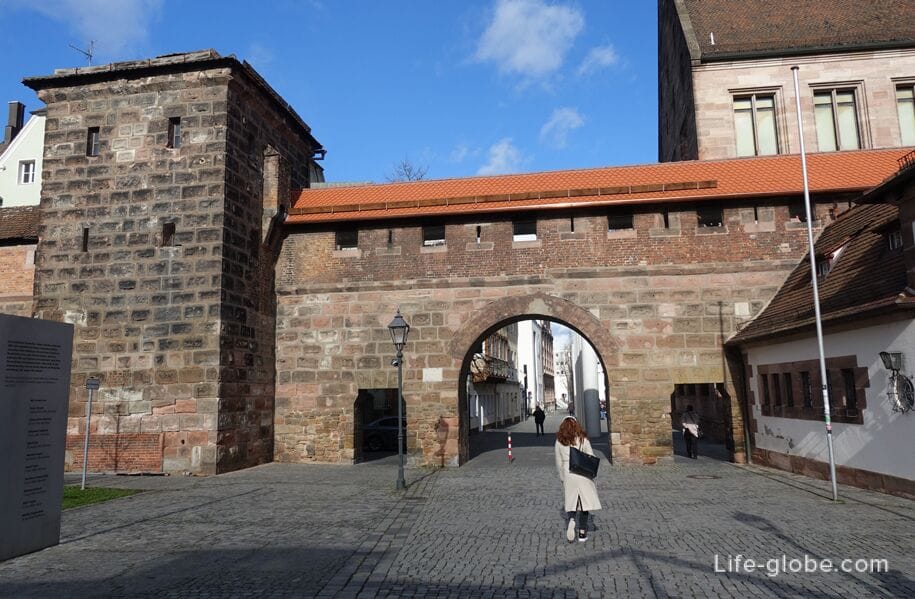
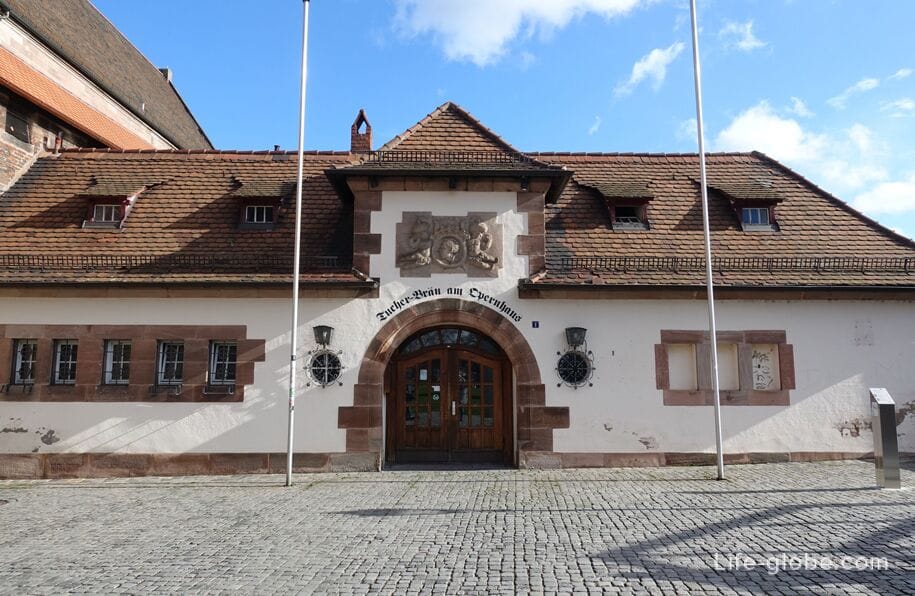
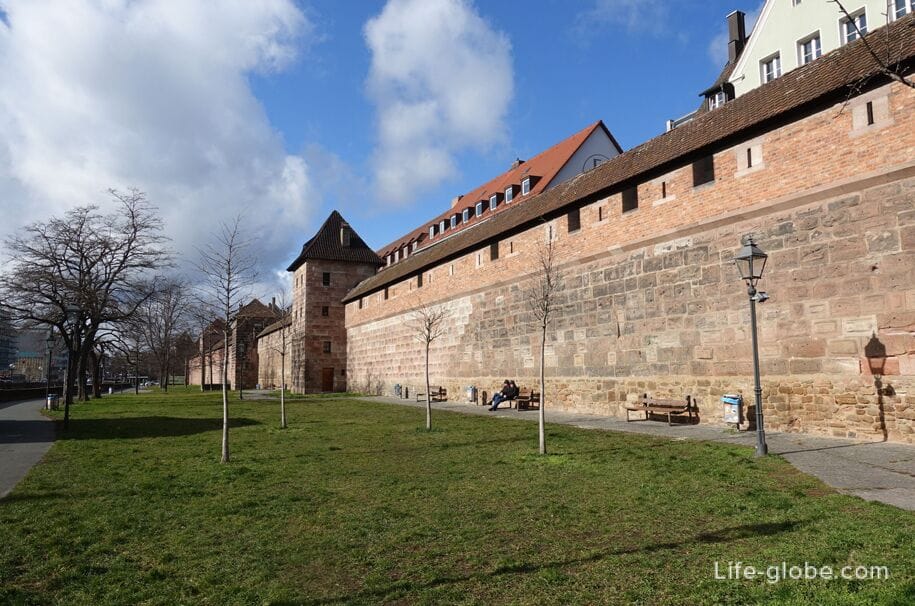
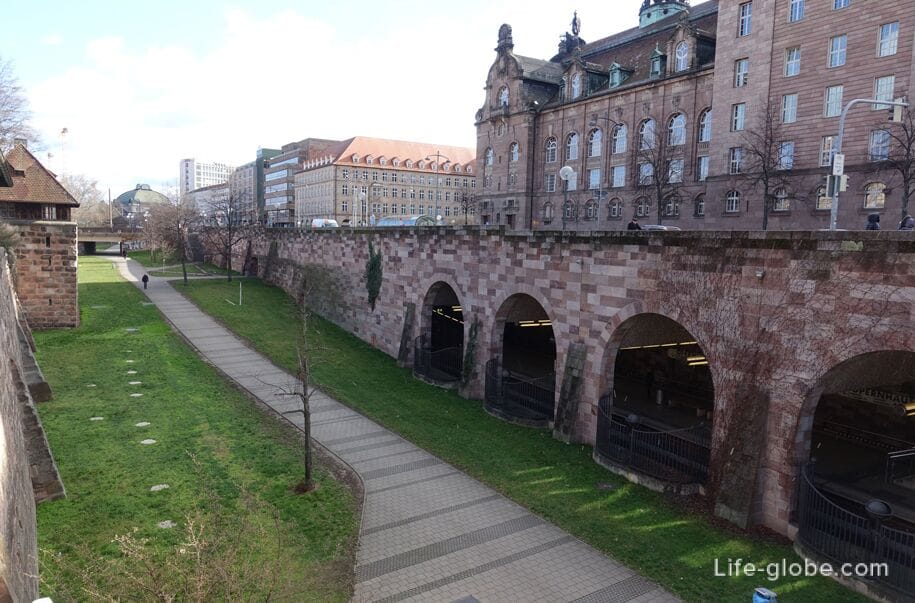
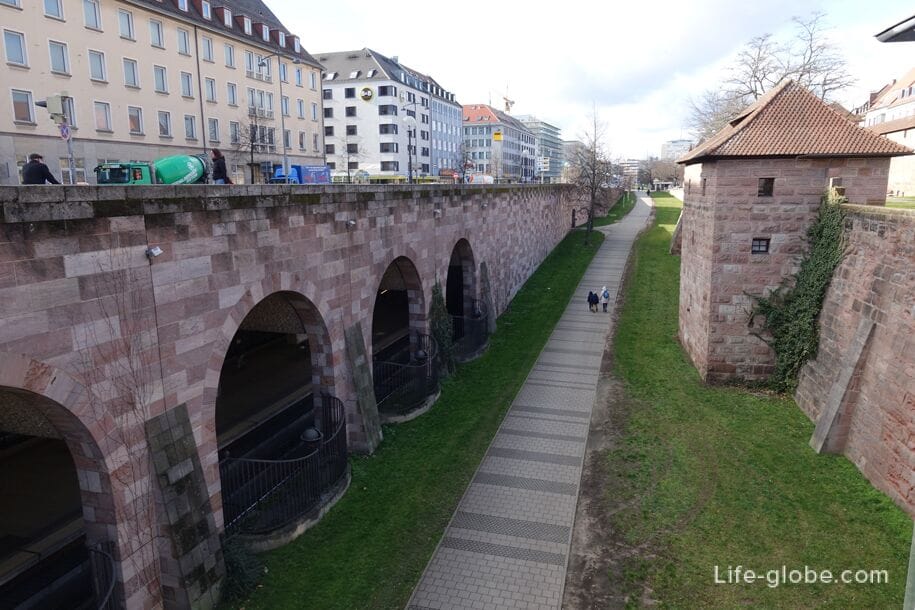
To the west, along the inner city wall runs the Nuremberg Red Light Street (Frauentormauer).
There is nothing particularly remarkable on the street. Girls can be seen in the windows of rooms on the first floors of buildings.
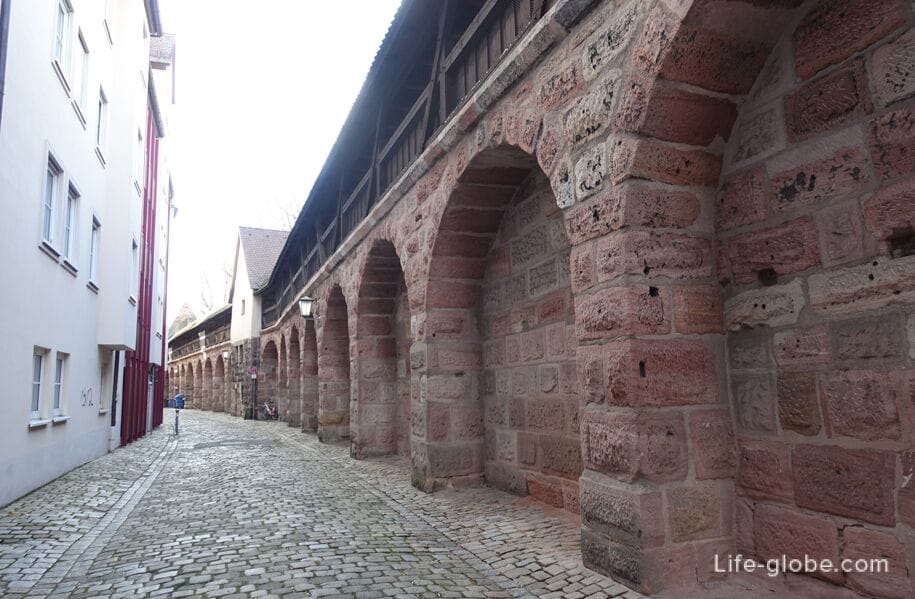
The Spittlertor is one of the four distinctive round main towers of the Nuremberg city fortifications. The name refers to what was then the nearby St. Elizabeth Hospital.
During the Second World War, the tower was used as a bunker, and since July 2006 it housed the library and archive of the Nuremberg Garrison Museum. Today the tower is empty.
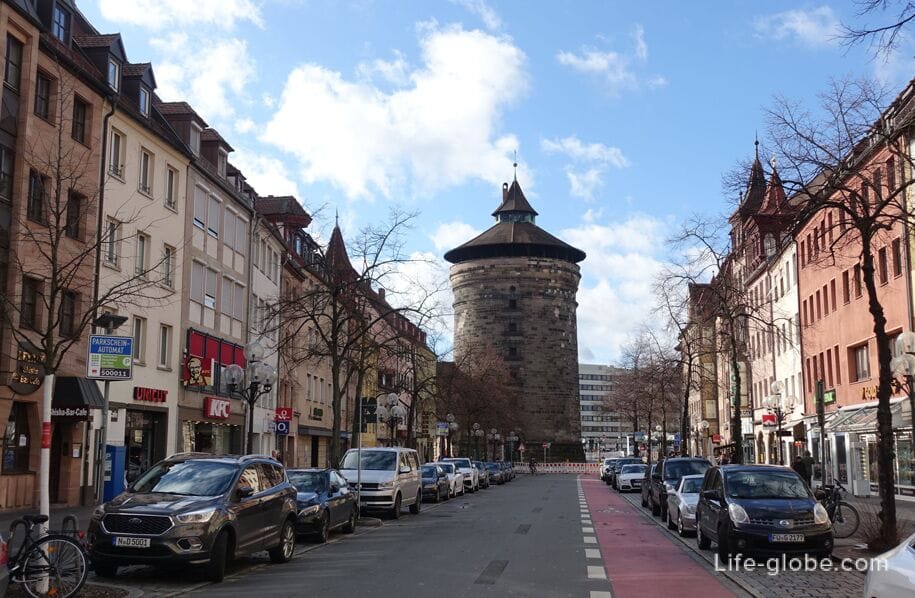
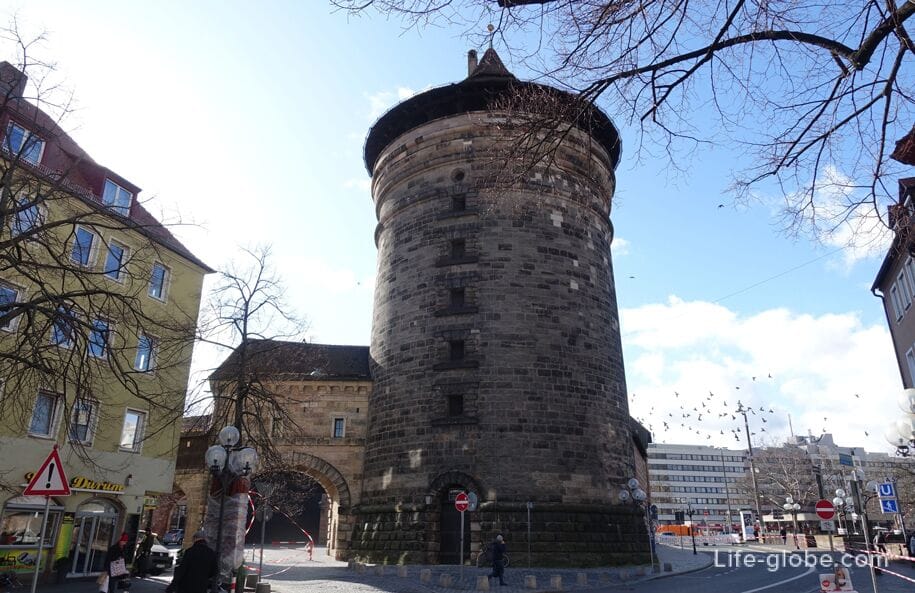
The wall is next. In 1997-2003, the Museum Tower of Feelings in Mohrenturm at the western gate was designed and built.
In the museum tower of feelings there is an interactive museum (turmdersinne). Website: turmdersinne.
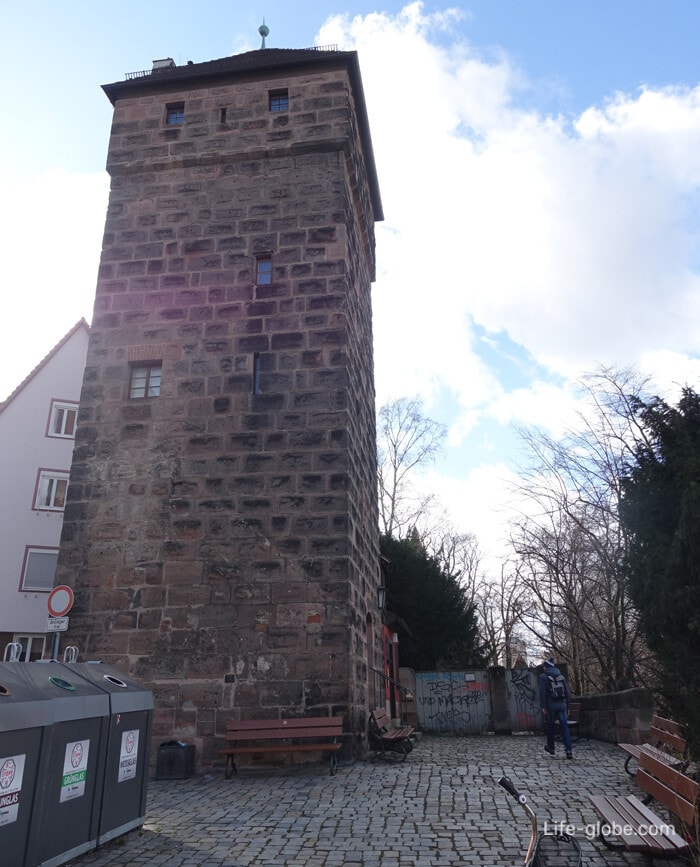
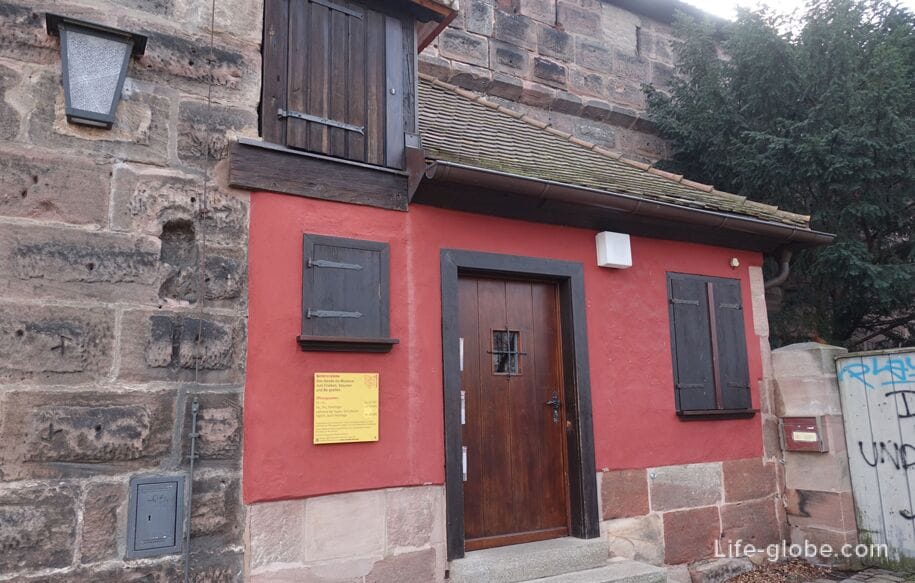
The West Gate (Westtor) is the former lost gate of the Nuremberg city wall, on the site of which one of the main transport and technical entrances to the western old city of Nuremberg takes place today.
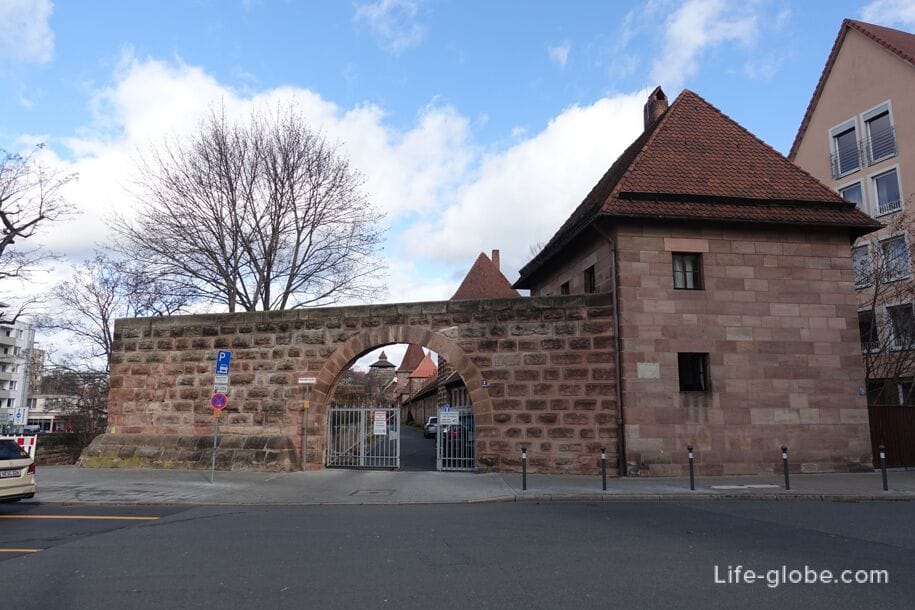
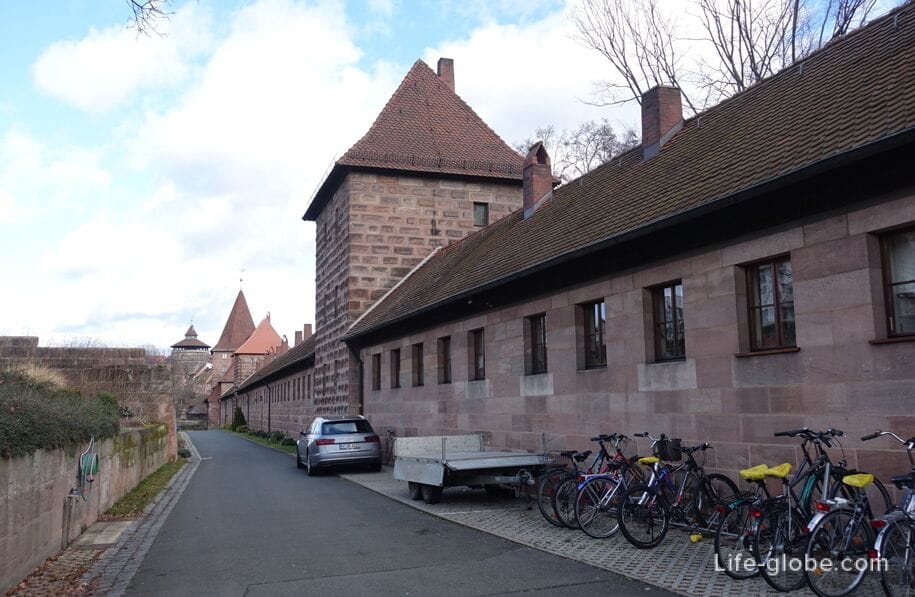
A chain bridge with a section of the city wall and fortifications, located in the central western part of the wall of the old city.
Here are:
- Fronveste (Fronveste) - a one-story block building made of sandstone, which was erected in 1490 in the form of a bridge on a support with a gable roof, and was used as an arsenal.
In the 19th century, the building was used as a prison, hence the current name. In 1938 it was converted into a nursing home and destroyed during the Second World War. It was reconstructed in 1957;
- the Schlayer Tower (Schlayerturm), which connects to the city wall and stands in the middle of the mouth of the Pegnitz River on a small river island.
A powerful square tower was built to protect the outflow of the river in 1419-1422 from sandstone with a pointed octagonal hipped roof.
In 1519, weaknesses in the foundation were discovered and the height of the tower was reduced.
On the north side of the tower adjoins the former bridge over the northern arm of Pegnitsa, which was built at the end of the 15th century as a massive pedestrian walkway made of sandstone blocks with a gable roof;
- Chain bridge (Kettensteg), which runs across the Pegnitz River at the inner side of the wall. Learn more about the bridge and fortifications...
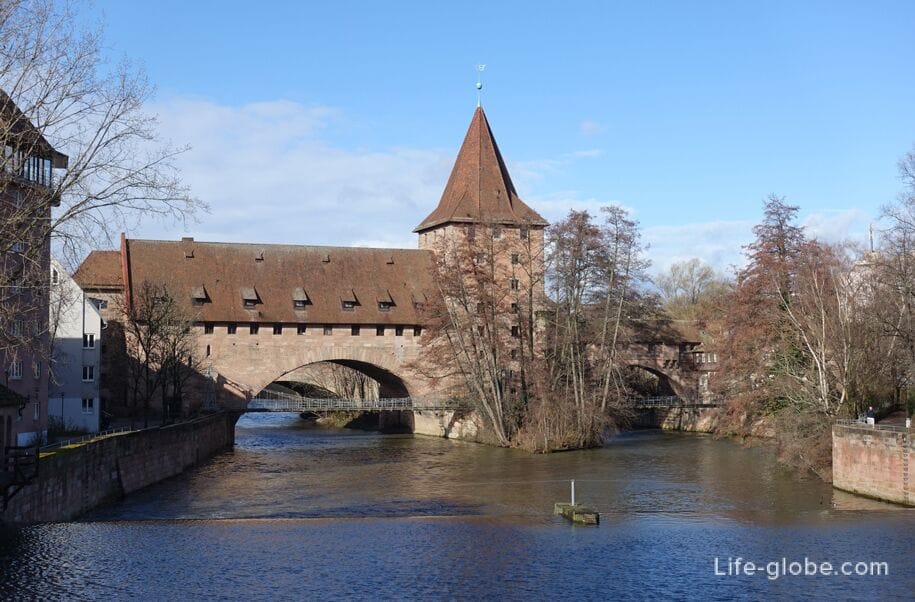
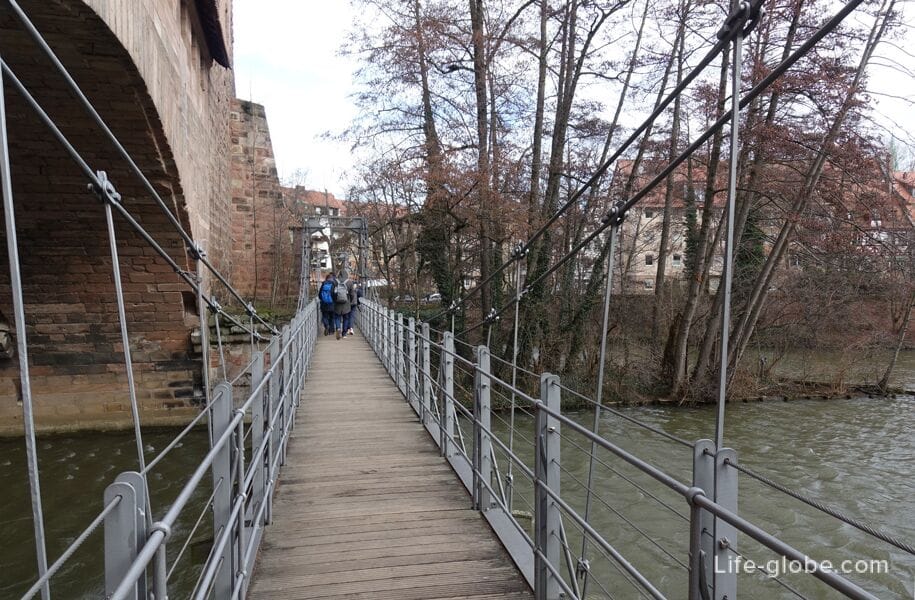
In the north direction, a Chain bridge leads to the city wall with a thin pointed tower, in which the Haller pedestrian gate (Hallertürlein) is located.
This section of the city fortifications acquired its current appearance after repairs in 1519.
Near the Haller Gate and the Chain Bridge there is a restaurant "Elke's Bierstadl im Kettensteg" with a small beer garden.
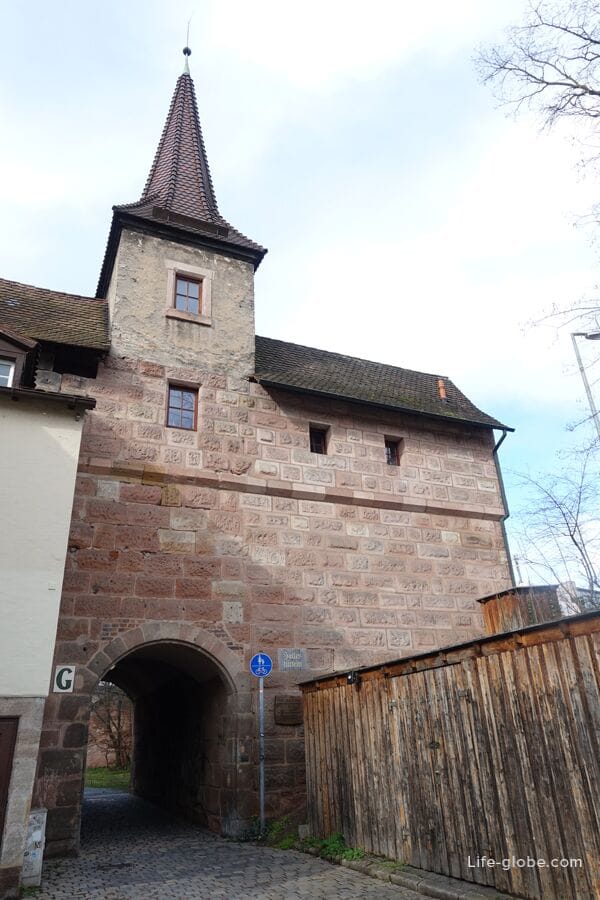
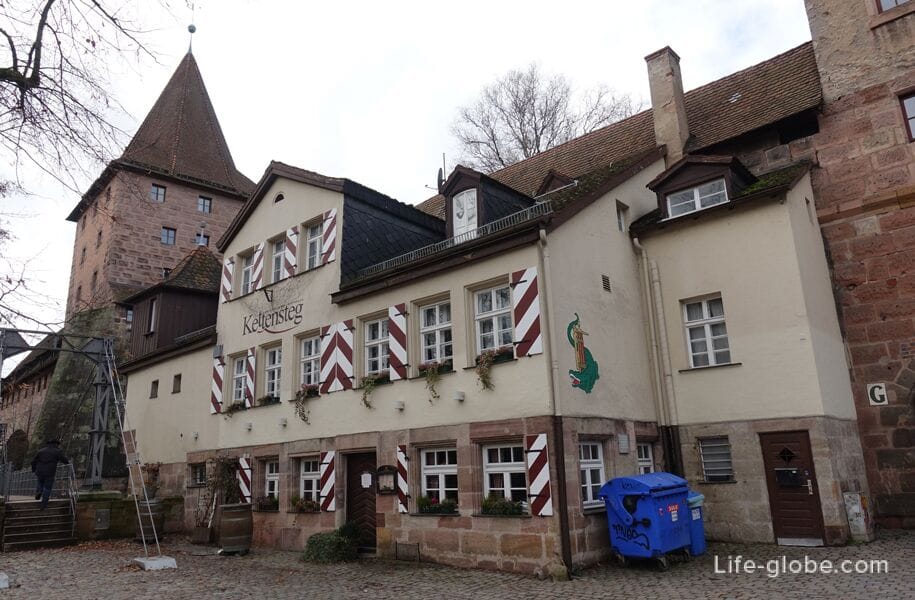
Further noteworthy is the ensemble consisting of the Noitor Tower (Neutorturm), the Noitor Bastion (Neutorbastion) and the Noitor Gate (Neutorturm).
The Neutor Tower is one of the four characteristic round main towers of the Nuremberg city fortifications. And the Neutor Gate was one of the four main gates of the Nuremberg city fortifications.
The gate leads to a bridge that runs over the former moat.
There is a garden on the bastion, which is open to the public in the warmer months.
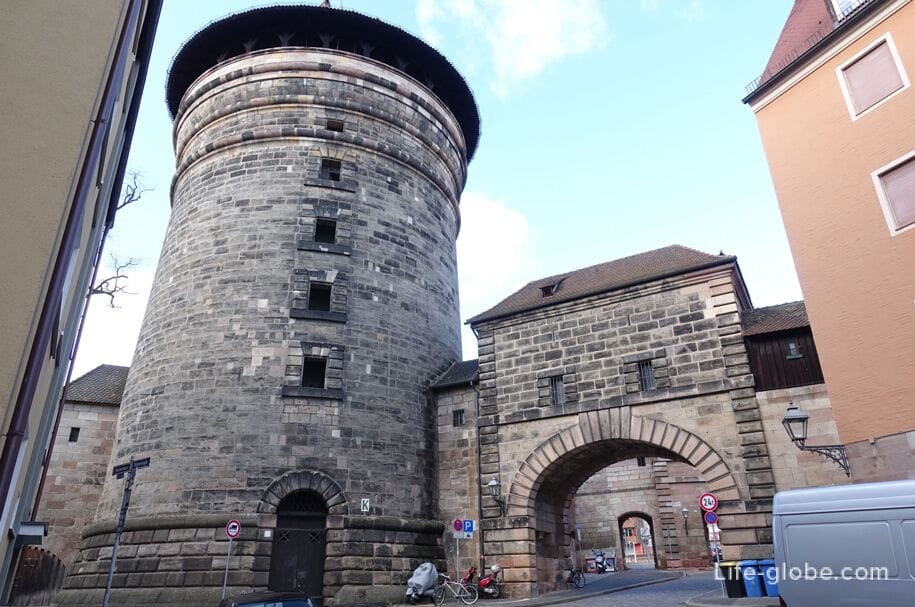
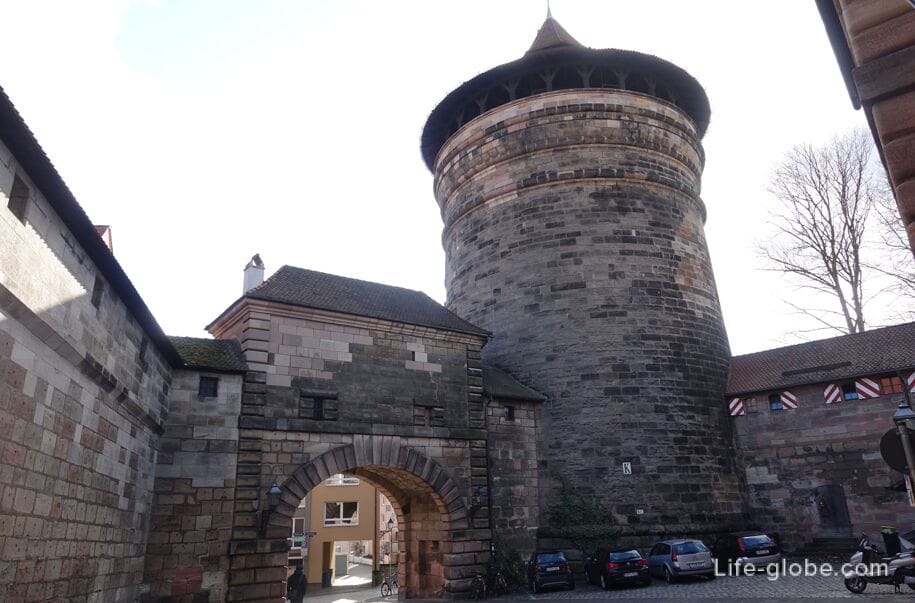
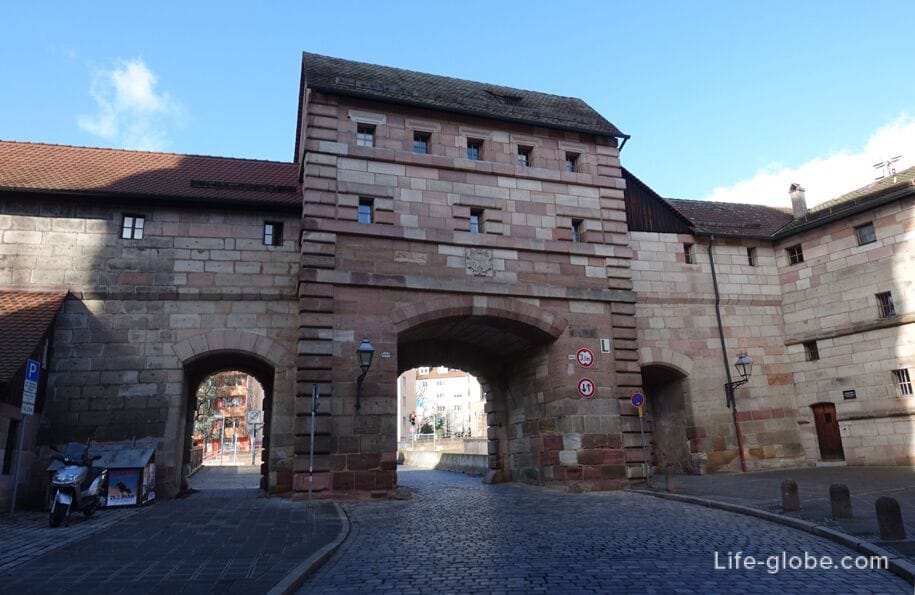
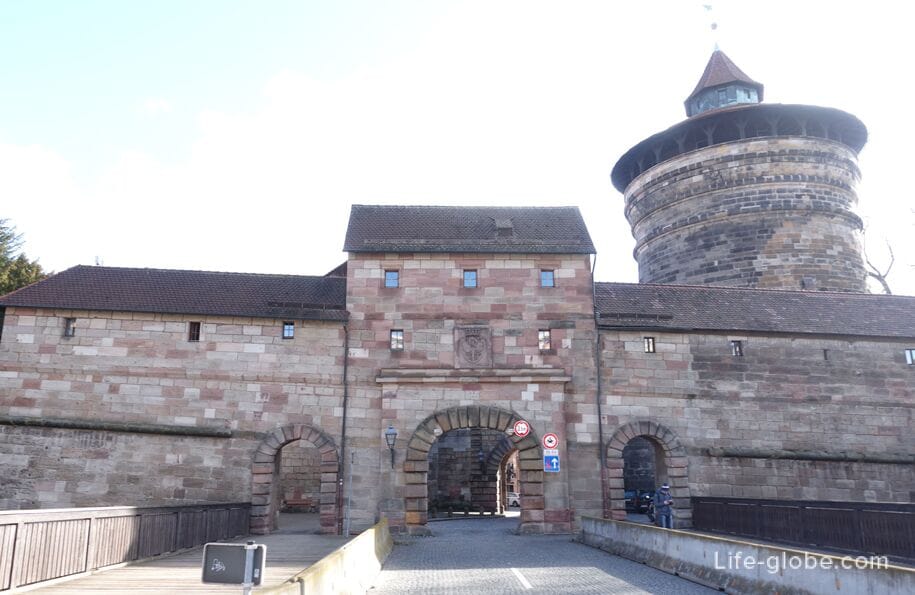
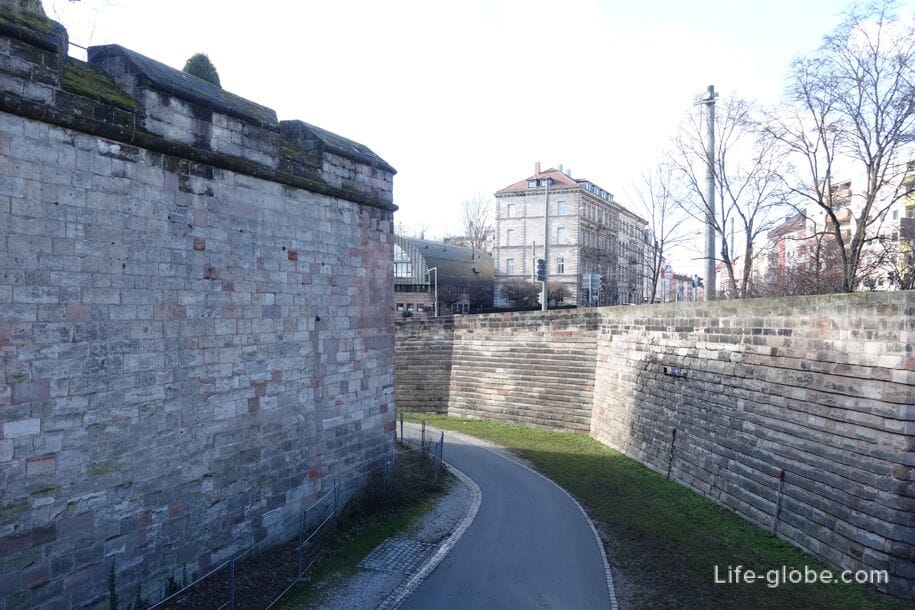
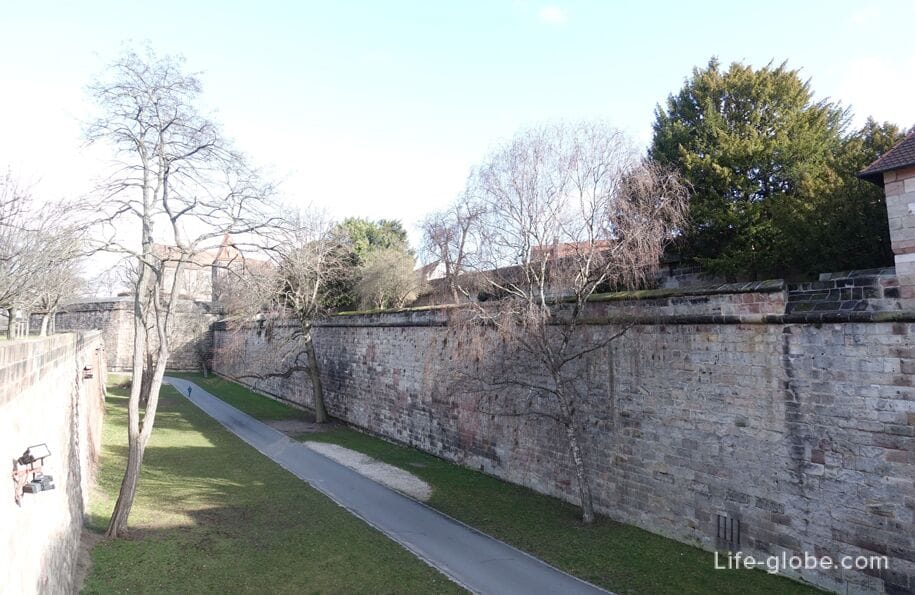
To the north, the Tiergartnertor Gate (Tiergärtnertor) and Tiergartnertor Tower (Tiergärtnerturm) are notable, behind which is the Lower Bastion (Untere Bastei), on which the southern garden of the Imperial Palace (Südlicher Burggarten) is laid out.
The high pointed gate tower, which has a square base and a barbican, dates from the end of the 13th. The two upper floors with polygonal projecting corners were added in 1516. A small building adjoins the gate tower, in which a cafe is located.
On the inside of the gate is the Tiergärtnertorplatz square on which Durer House Museum (Albrecht-Dürer-Haus) and the famous sculpture "Durer's Hare" (Dürer-Hase Skulptur). Learn more about the square and the gate...
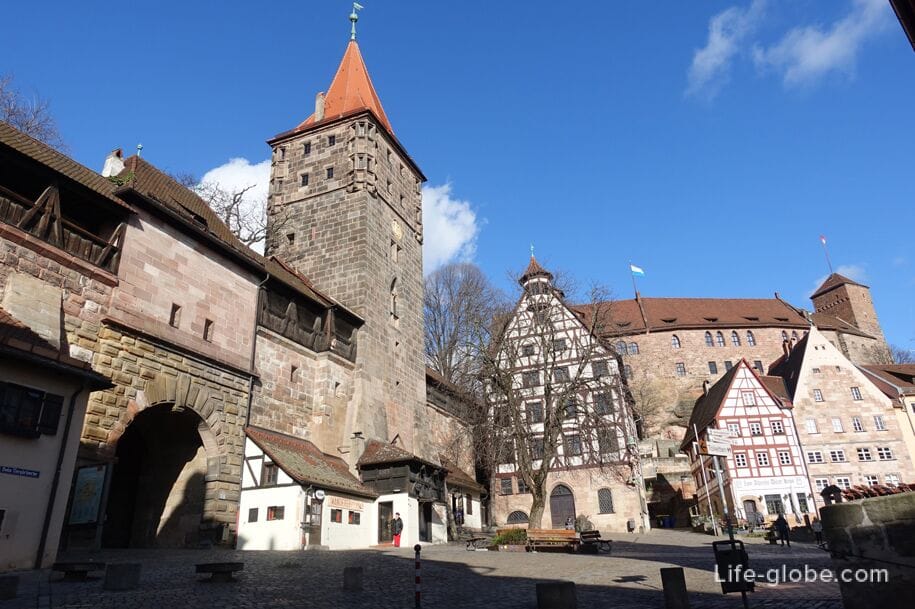
From the north-western side of the fortifications of the city is remarkable Nuremberg Fortress (Nürnberger Burg), also known as Kaiserburg Castle (Kaiserburg Nürnberg) - the former residence of the rulers.
Today, the Nuremberg Fortress is a symbol and the main attraction of the city. It is a group of medieval fortified buildings and is considered one of the most formidable medieval fortifications in Europe, which personified the power and importance of the Holy Roman Empire, as well as the outstanding role of the imperial city of Nuremberg.
Museums are located in part of the fortress premises. More about the Nuremberg Fortress...
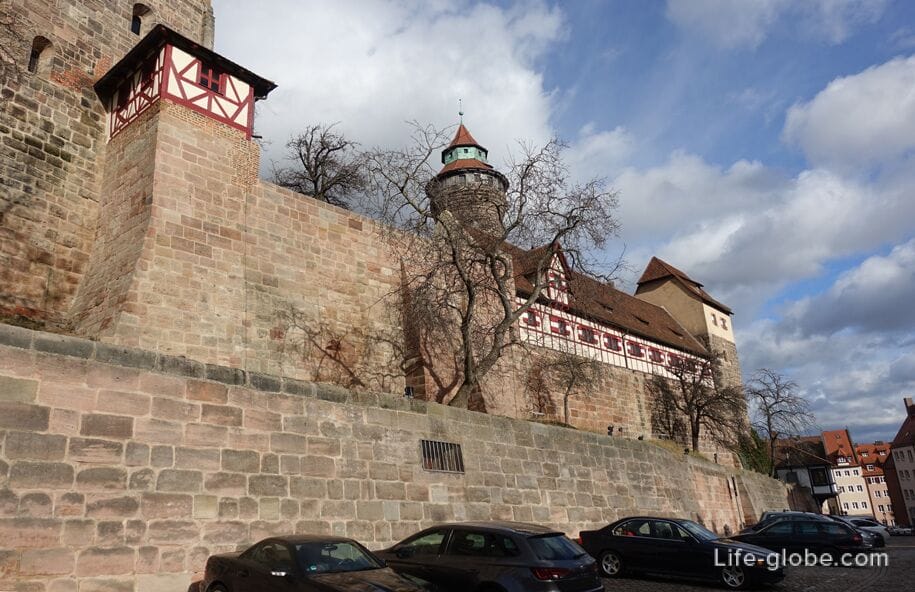
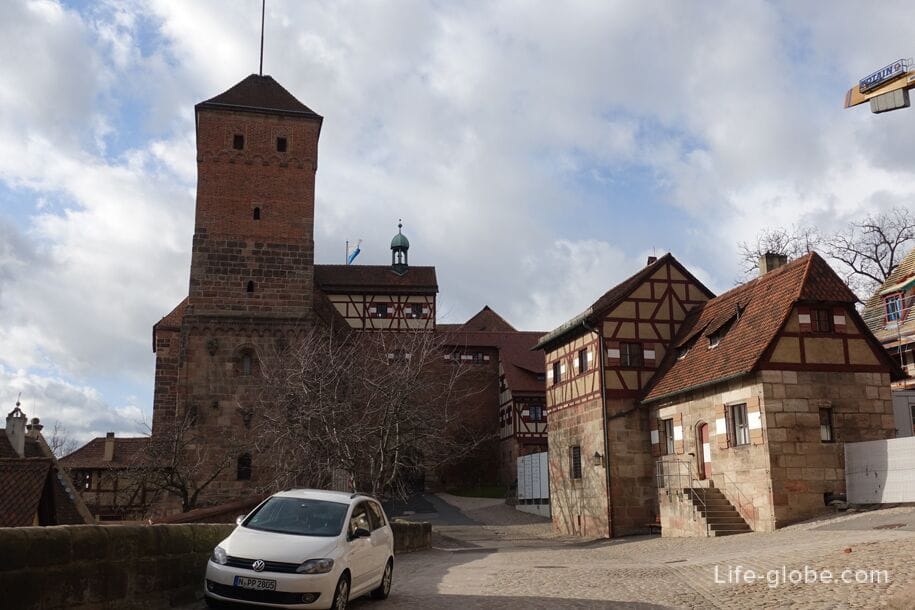
In the north-eastern part of the old town stands the round tower of Laufer (Laufer Torturm), which was originally part of the Laufer Tor gate, but at the end of the 19th century the system was adapted to the requirements of the growing city, and all structures except the round tower were demolished.

In the central eastern part of the old town, near the island of Schutt, a bright ensemble stands out Tratzenzwinger - part of the fortifications with a tower, casemate gates, casemates, ramp and bridge.
The Tratzenzwinger defensive tower is used as a Krakow House (Krakauer Haus), which also uses parts of the bastion. In addition to the representative office of the city of Krakow, there is a travel agency and a restaurant with a summer beer garden.
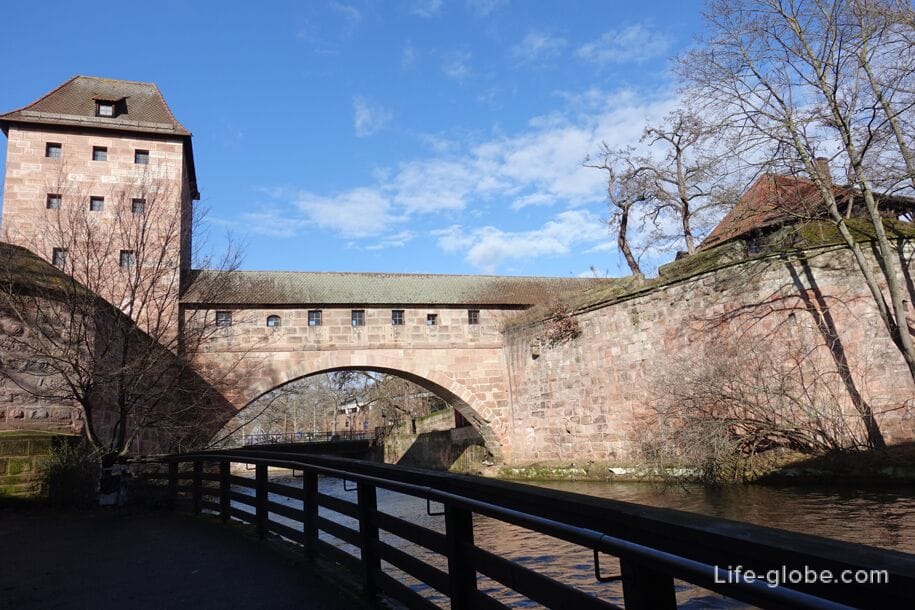
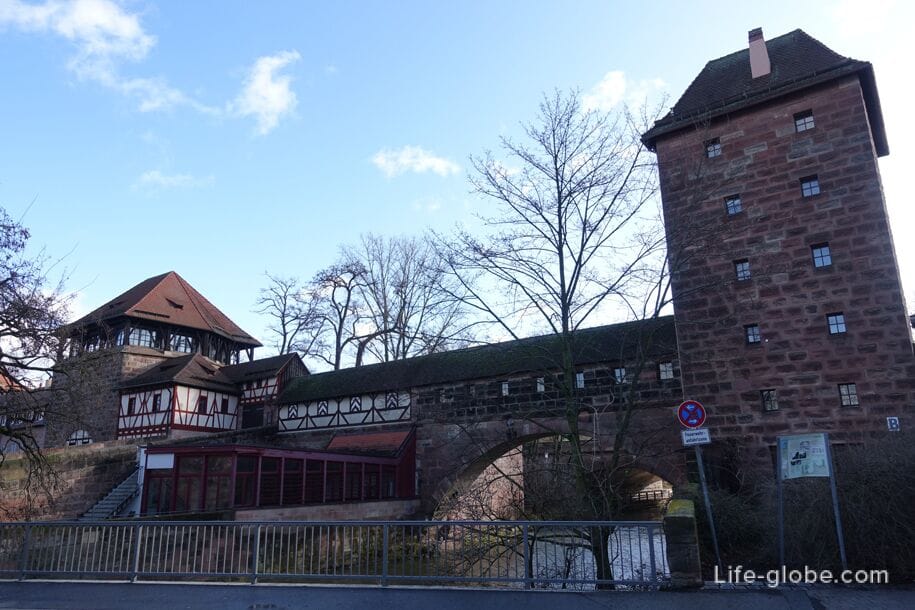

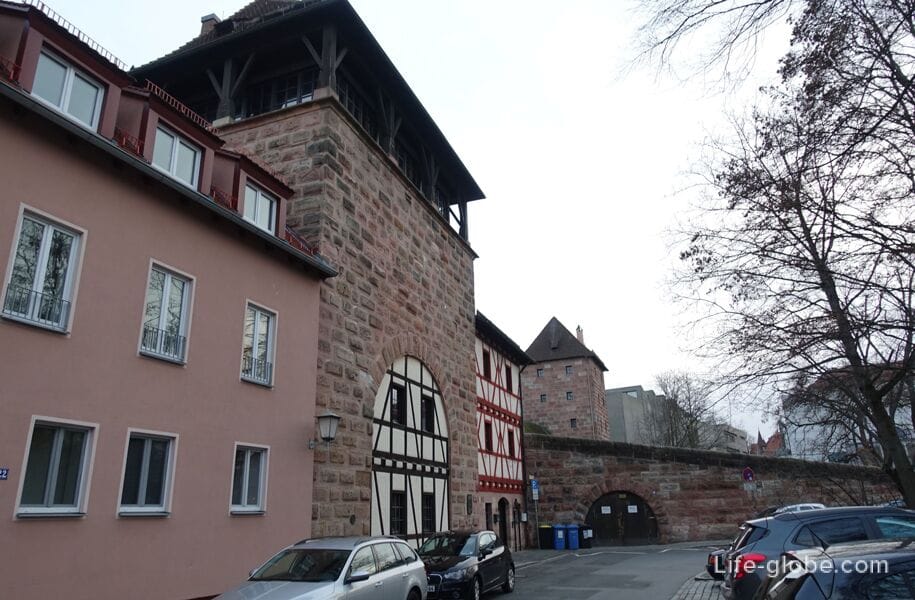
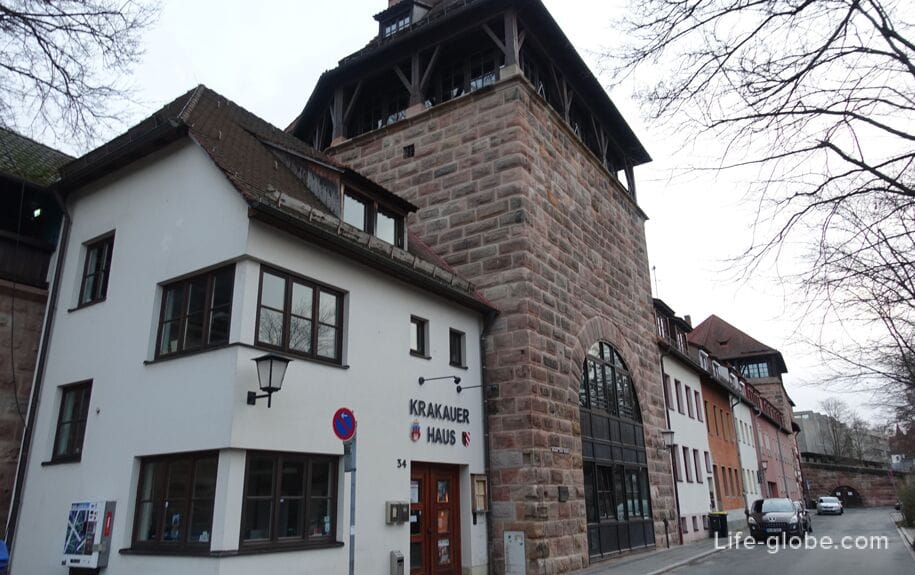
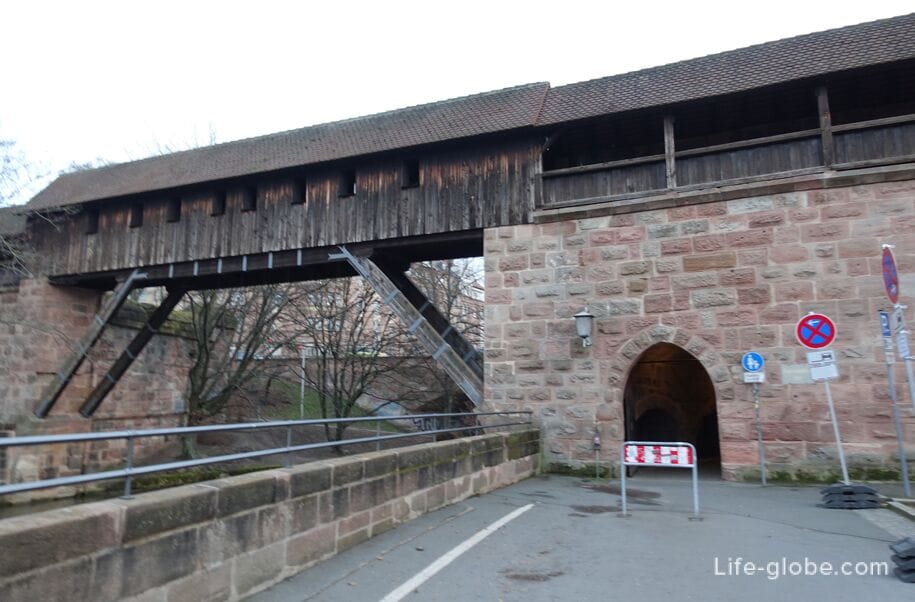
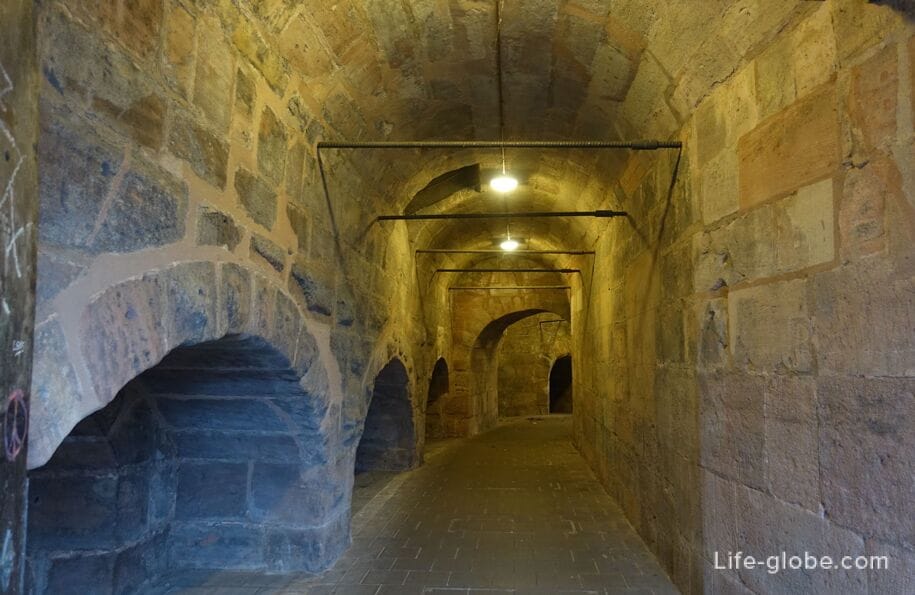
In the south-eastern part, a building adjoins the wall Kunsthalle is an art gallery in Nuremberg.
The gallery was opened in 1967 as a place to showcase international contemporary art. The museum building was built in 1912 according to the plans of the architect Otto Seegy as an exhibition hall "Kunstausstellungshalle am Marientor".
Today, the museum organizes exhibitions of contemporary and international artists.
The museum's website: kunstkulturquartier.de/kunsthalle .
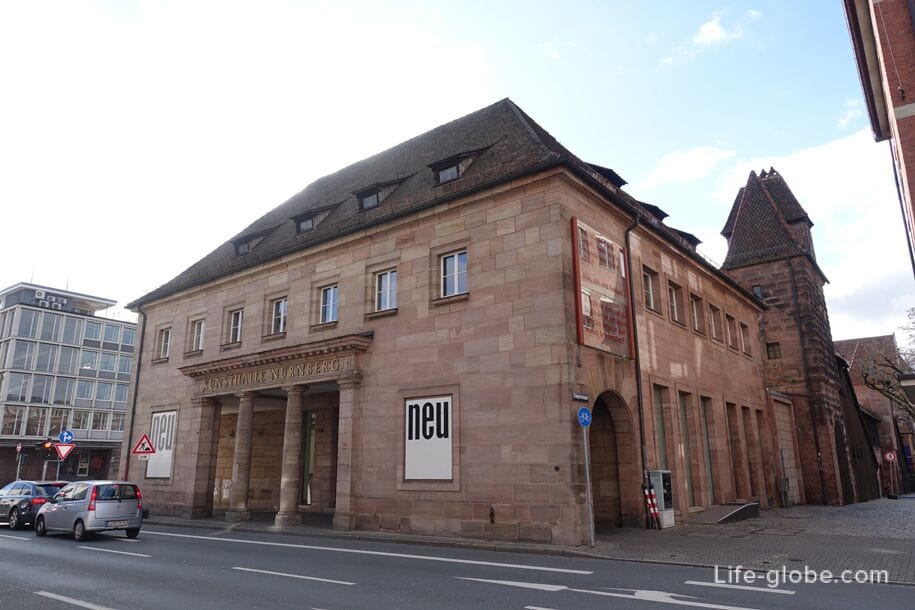
All accommodation facilities in Nuremberg, including in the city center and more remotely from it, can be viewed and booked here




